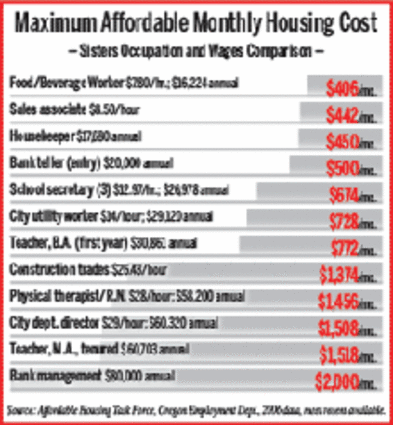Sisters continues to wrestle with 'affordable housing'
Last updated 8/5/2008 at Noon

The City of Sisters has struggled for years to figure out how to encourage the development of "affordable housing" in a community where people are willing to pay a premium for quality of life.
Now the City Council is at work on a new housing plan, which they hope to adopt this month. The plan will address how the community can provide housing opportunities to people with low incomes.
"Affordable housing" is defined as housing in which residents spend no more than 30 percent of their gross household incomes on housing-related expenses. Households are considered "cost-burdened" if they pay more than 30 percent of total household income on housing costs.
Housing-related expenses are defined by HUD (U.S. Department of Housing and Urban Development) as follows: For homebuyers, housing-related expenses include mortgage principle and interest, taxes, property insurance, mortgage insurance, and essential utilities. For renters, housing-related expenses include rent and utilities.
For a "for-sale home" to be considered affordable in Deschutes County, based on the 2007 AMI (Area Median Income based on a family of four - $58,800), it would need to be less than $180,500.
How many Sisters-area homes are now on the market with a list price of $180,500 or less right now? Zero. There are approximately 239 homes listed above that selling price, according to a July 25 listing report.
Working wages for many jobs in Sisters make it a stretch for local workers to live in the community (see data previous page).
As of January 2008, the average price of homes listed on the MLS (Multiple Listing Service) within the Sisters City limits was $361,763. The median home price for the same period was $314,900. Based on the MLS listings, there were no homes that are considered "affordable" for a household earning the Deschutes County AMI within the Sisters City limits.
The lowest-priced listings in the city in January 2008 included two townhomes priced at $199,990, and the July 25 Sisters-area listing report shows no homes under $198,000.
Workforce Assessment estimated that the maximum affordable rent for a family earning a median family income was $1,058.75 in 2006. According to a rental survey in early 2007, 36 percent of available rental units in Sisters were not affordable to a family earning median family income.
The Sisters Comprehensive Plan contains policy that directs the city to develop an action plan to ensure that Sisters' long-term housing supply is affordable to a variety of income levels through the planning period of 2025.
The policy states that: "The City shall develop a coordinated and comprehensive Housing Plan that will provide housing choices to all income levels in the City. The following objectives shall be incorporated into the plan:
a. The Housing Plan shall explore and recommend how one in ten of all new housing units built in the City by 2025 can be made affordable to families with low incomes.
b. The Housing Plan shall explore and recommend the use of appropriate tools including, but not limited to: accessory dwelling units, annexation policies, development incentives, fee waivers for deferrals, down payment assistance programs and gap financing, employer housing assistance (non-residential development), equity pool or shared equity programs, land trusts, land banking, mixed use, mobile home parks, residential density bonuses and increases, flexible zoning, affordable housing trust funds, and UGB expansions.
c. The Housing Plan shall address how affordable housing can be dispersed throughout the City."
The Sisters City Council, with the assistance of Susanna Julber, Consulting Planner, and Eric Porter, Planning and Community Development Director, is holding a series of workshops to understand and set the direction for the Housing Plan.
The target date for adoption of the Sisters Housing Plan is September 30.
In their July 24 workshop the councilors agreed that emphasis should be given to those earning 60 to 120 percent of the AMI, not the typical 80 to 120 percent used in other communities.
The 1-in-10 formula to determine the number of affordable units to "strive for" was discussed.
Councilor Sharlene Weed, who is executive director of the Sisters chapter of Habitat for Humanity, said, "we need to re-evaluate this ratio."
















Reader Comments(0)